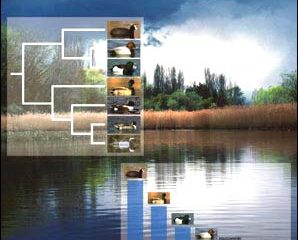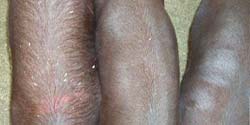
Nature has many patterns and ecologists seek to both describe and understand them. Nature also is very complex. One challenge is to find patterns in that complexity and to ask whether simple explanations lie beneath them.
Ecologists have tackled this challenge for decades, erecting various hypotheses and debating their plausibility. In an important paper featured in the current issue of the Proceedings of the National Academy of Sciences (PNAS), an international team of ecologists describes

New research at North Carolina State University’s College of Veterinary Medicine indicates that cloned pigs can have the same degree of variability in physical appearance and behavior as normally bred animals. Two separate studies show that while clones are genetically identical to the original animal, the similarities end there.
This dispels the commonly held notion that cloned animals retain the physical and behavioral attributes of the animal from which they were cloned. The research was

A new type of very thin solar cell made from inexpensive materials has been invented by researchers at the Hahn Meitner Institute in Berlin, Germany, in collaboration with a colleague now at Portland State University, Oregon, USA. The new device will be much cheaper to make because it uses less expensive semiconductor materials than conventional solar cells. The researchers publish details of their invention in the Institute of Physics journal Semiconductor Science & Technology on 14 April 2003.

Scientists at the John Innes Centre (JIC) (1), Norwich, UK1 and the INRA (Institut National de Recherche Agronomique) at Evry, France(2) have today announced the creation of the largest library of genetic resources, for the study of wheat, in the world. The two scientific teams have exchanged so-called BAC libraries(3) that when combined together, represent the entire genome(4) of wheat. The research material in the libraries, and associated information, is freely available to academic and industrial scient

Prolactin, a naturally occurring peptide hormone needed for milk production following pregnancy, has been found to play a major role in the development and spread of breast cancer. More recently, Dr. Charles Clevenger, the same researcher who first demonstrated the scope and mechanism of prolactin’s role in cancer, has discovered that prolactin functions directly inside the cell, not merely by sending signals across the cell membrane as had been assumed for it and all other peptide hormones.

Dr. Wesley Sundquist, professor of biochemistry at the University of Utah, will present at the Experimental Biology 2003 meeting in San Diego on his work in elucidating how HIV is manufactured and assembled in the cell.
The raison d’être of a virus such as HIV, if a non-living thing can be said to have one, is to turn a host cell into a factory that churns out virus copies and releases them to infect other cells. Dr. Sundquist’s research has focused on discovering the mechanisms u

– new calculation confirms standard model of particle physics. Contribution of hadronic vacuum polarization determined with unprecedented accuracy. The magnetic moment of the muon is an important precision parameter for…
Technique may prevent formation of unwanted waves that siphon off needed energy. Heating plasma to the ultra-high temperatures needed for fusion reactions requires more than turning the dial on a…

An international team of astronomers, led by researchers from the Astronomical Observatory of the University of Warsaw, have identified a new class of cosmic X-ray sources. The findings have been…

How deubiquitinases USP53 and USP54 cleave long polyubiquitin chains and how the former is linked to liver disease in children. Deubiquitinases (DUBs) are enzymes used by cells to trim protein…

Conceptual blueprint to analyze experimental catalyst data. Machine learning (ML) models have recently become popular in the field of heterogeneous catalyst design. The inherent complexity of the interactions between catalyst…

Antibody that Neutralizes Inhibitory Factors Involved in Nerve Regeneration Leads to Enhanced Motor Function after Acute Spinal Cord Injury. Researchers at 13 clinics in Germany, Switzerland, the Czech Republic and…

How simulations help manufacturing of modern displays. Modern materials must be recyclable and sustainable. Consumer electronics is no exception, with organic light-emitting diodes (OLEDs) taking over modern televisions and portable…

“Neurons that fire together, wire together” describes the neural plasticity seen in human brains, but neurons grown in a dish don’t seem to follow these rules. Neurons that are cultured…

The quest for sustainable energy solutions has been a major focus of scientific research for decades. Solar energy, a clean and renewable source, has emerged as a promising alternative to…

With a processing speed a billion times faster than nature, chip-based laser neuron could help advance AI tasks such as pattern recognition and sequence prediction. Researchers have developed a laser-based…

New technology could remotely identify various types of plastics, offering a valuable tool for future monitoring and analysis of oceanic plastic pollution. Researchers have developed a new hyperspectral Raman imaging…

Artificial Intelligence (AI) has established a strong presence across industries, large and small. The “VoBaKI” research project has empowered small and medium-sized enterprises (SMEs) with an innovative tool to independently…